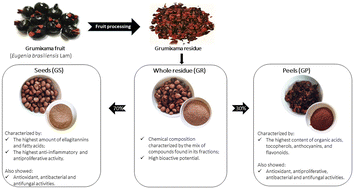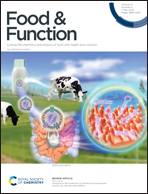Brazilian berry waste as a source of bioactive compounds: grumixama (Eugenia brasiliensis Lam.) as a case study
Abstract
Grumixama, Eugenia brasiliensis Lam., is a Brazilian berry little explored commercially and scientifically. However, local small producers market this fruit in the form of frozen pulp, which generates bioresidues, composed of seeds and peels. With the view to propose strategies for valuing grumixama, this study aimed to determine the chemical composition and assess the bioactivities of the hydroethanolic extracts of the whole residue (GR), seed (GS) and peel (GP) fractions of E. brasiliensis. From the results, GP had the highest concentration of organic acids (oxalic, malic, ascorbic and citric acids), total tocopherols, condensed tannins, anthocyanins, and other flavonoids. On the other hand, GS showed the highest content of monounsaturated fatty acids and hydrolysable tannins, whereas GR displayed a mixture of compounds detected in each of its parts. Regarding the bioactivities, low extract concentrations were required in two in vitro antioxidant assays, namely TBARS (EC50 = 0.90–1.34 μg mL−1) and OxHLIA (IC50 = 21–65 μg mL−1). Furthermore, GP had the highest inhibition activity of cellular oxidation in the CAA assay (80 ± 0.6%), while GS showed the highest anti-inflammatory activity via nitric oxide production inhibition (EC50 = 98.0 ± 0.5 μg mL−1). All samples induced cell growth inhibition of the tested tumor cells (GI50 = 14.7–186 μg mL−1) besides antibacterial and antifungal effects at low concentrations, but all samples were harmful to normal cells at moderate concentrations (GI50 = 145–268 μg mL−1). Therefore, E. brasiliensis residue could be a good source of bioactive compounds to be used in several areas. However, additional studies are needed to confirm its safety as well as to unravel the mechanisms behind its biological activities.

- This article is part of the themed collection: Food & Function HOT Articles 2023


 Please wait while we load your content...
Please wait while we load your content...